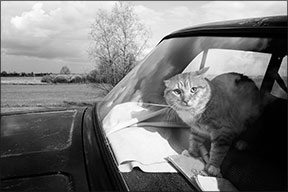If you’re taking your cat or cats on vacation this summer, you’ll be in pet-loving company. Six percent of owners take their cat with them when they travel two nights or more, according to the American Pet Products Association.

288
The percentage may not sound impressive, but consider that 39 million households in the U.S. own one or more cats — the average is 2.1 — and that means almost a half a million cats will be on the road, hopefully all of them in carriers. That’s the most important travel recommendation from Gretchen L. Schoeffler, DVM, a specialist in emergency and critical care at Cornell University College of Veterinary Medicine.
“It is imperative that cats travel in a carrier while in the car, preferably a crate that is buckled in,” says Dr. Schoeffler, Section Chief of the Emergency and Critical Care Service. “When loose, cats simply become projectiles in the case of a quick stop or accident, injuring themselves and others.”
Watch Those Claws. An unrestrained cat in the car is also a distraction and danger to the driver. “Can you imagine your cat freaking out, bouncing around with extended claws while you are driving 55 miles an hour on a busy highway?” Dr. Schoeffler asks. “A cat may get under a seat, under the dashboard or escape if a door or window is opened. Take the cat out of the carrier only when you have reached your destination.”
The carrier should be well-ventilated and large enough for your cat to stand and turn around. It should have space for a water bowl and, if you choose, a litter tray.
Here are more recommendations from Dr. Schoeffler for safety and well-being on the road:
To Reduce Stress
Cats often associate car rides with negative experiences, such as going to the veterinary clinic. Conditioning can help them overcome their anxiety. “Prior to the trip, let the cat explore the car while it is parked in the driveway,” Dr. Schoeffler says. “Make sure the cat doesn’t disappear under the dash board. By letting a cat explore the car, it becomes a less scary place — one that he can claim as his own.”
When your cat is comfortable in the stationary car, take him on short trips and slowly build up to longer ones. “By providing positive reinforcement — playtime and treats — each and every time he goes for a ride, he will become conditioned to enjoy the experience,” Dr. Schoeffler says.
She suggests using Feliway — a pheromone that tends to calm cats — in the car. It’s a synthetic copy of the feline facial pheromone that cats use to mark safe territory, available as a spray or diffuser. In addition, putting items with your cat’s scent, such as bedding or towels, in the car can help the environment seem more familiar.
To Prevent Car Sickness
Reduce stress and you’ll likely reduce motion sickness. It’s the primary reason for cats’ motion sickness, Dr. Schoeffler says. “You might also consider withholding food for eight hours prior to and during the actual travel time. An empty stomach may help reduce nausea.”
Meclizine (mek’ li zeen), marketed under several brand names, may be given for motion sickness but not for anxiety, Dr. Schoeffler says. Consult your cat’s veterinarian before giving any medications or supplements — even over-the-counter medications.
To Avoid Hyperthermia
“Cats don’t develop heat stroke as often as dogs,” Dr. Schoeffler says. “With that being said, you should never leave a pet in a car or confined space unattended. Not in the shade, not during the winter, not even with the windows cracked. “
When it’s 75 degrees outside, it takes only 10 minutes for the temperature inside a vehicle to reach 94 degrees. Ten minutes later, the interior temperature can hit 104.
Additionally, cats should always have access to water, Dr. Schoeffler says. “The only cats I have had to treat for heat-related illness have been left in a confined space unattended.”
To Manage Rest Stops — Or Not
If you have harness-trained your cat and he can happily walk on leash, he might appreciate a walk outdoors, away from crowds and other pets at rest areas. A more practical solution would be to pack a portable or disposable litter tray in his crate.
To Aid in Emergencies
In addition to obvious supplies such as food, bowls, first-aid kit, favorite toys, plastic bags, litter and scoop, don’t forget the not-so-obvious: an ID tag with your name and home and cellphone numbers, a copy of your cat’s medical records in the event he needs veterinary care and a photo of him in case he becomes lost — but your thoughtful care won’t let that happen. ❖



